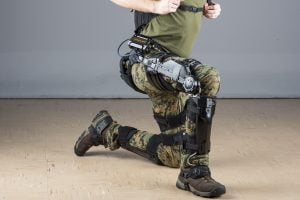AUSA: Okay, so it isn’t Iron Man. It isn’t Starship Troopers. But Lockheed Martin’s ONYX exoskeleton has one huge advantage over those fictional icons: It’s real. Our reporter Paul McLeary wore it himself as he walked around the floor of this week’s massive Association of the US Army conference, as you can see in the video.

Lockheed Martin’s ONYX exoskeleton
ONYX is basically a robotic, motorized knee brace. It doesn’t help soldiers leap tall buildings, shrug off gunfire, or carry huge videogame-style guns. What it does do is take enough weight off the wearer’s knee — notoriously prone to injuries among troops laden with bullets, armor, and supplies — and quadriceps — which wear out quickly climbing Afghan mountainsides or urban staircases — so they can keep going longer without risk of injury. The Army is intensely interested in issuing the system to its foot troops, especially for urban warfare, where they may have to fight up and down dozens of flights of stairs.
Full-body armored exoskeletons have been a dream of military science fiction and superhero stories for decades, but it’s taken a long time just to develop partial systems like ONYX. That’s for two main reasons: It’s very hard to build a power source light and compact enough that the system doesn’t weigh you down more than it helps you; and historically it was even harder to make a mechanical system move with your body in a natural way, so it saves you energy instead of wearing you out.
But modern electronics have gone a long way to solving these problems, with miniaturized sensors, compact actuators, and sophisticated software to match the movement of the machine to the movement of the wearer’s body. And an emerging field called soft robotics holds the potential for even lighter and more flexible equipment in the future.
Sullivan says Ukraine supplemental should cover all of 2024, long-range ATACMS now in Ukraine
“We now have a significant number of ATACMS coming off their production line and entering US stocks,” Jake Sullivan said today. “And as a result, we can move forward with providing the ATACMS while also sustaining the readiness of the US armed forces.”



























